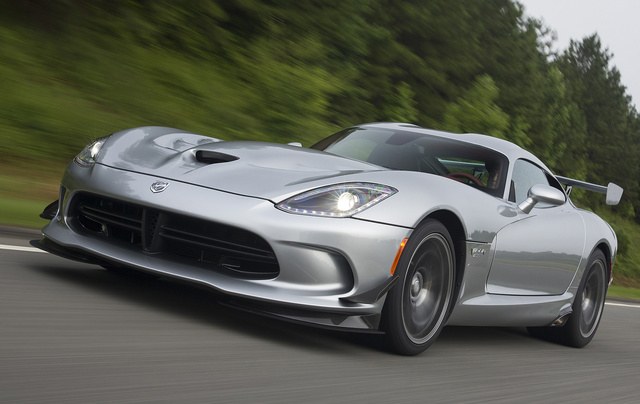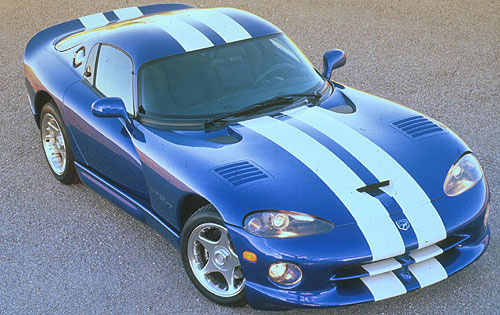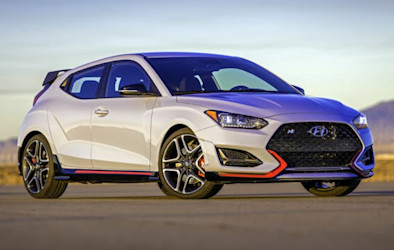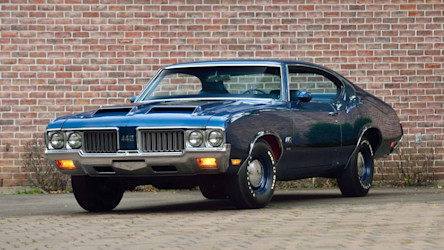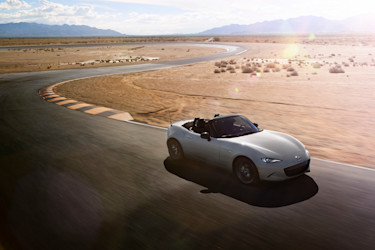The Dodge Viper, a two-seat sports car available in coupe and roadster body styles, is one of the most dramatic vehicles produced by Detroit’s Big Three automakers in the past several decades. The Viper is a product of the late 1980s, based on Chrysler president Bob Lutz’s idea of being a modern, mass-produced version of the Shelby Cobra. This supercar would go on to compete with the evergreen Chevrolet Corvette, as well as some Porsche sports cars.
The wild, exotic styling of the concept car got great reaction from the American public, and there were rumors that Lamborghini, then a subsidiary of Chrysler (just like Dodge) had assisted with the design. That was perhaps wishful thinking, although Lamborghini did pitch in on some initial work for the Viper’s engine, and it went on sale in January 1992, featuring an 8.4-liter V10 engine and an MSRP of $52,000.
The Viper RT/10 Roadster was loud and coarse—essentially street-legal race car—with a canvas roof, vinyl windows with zippers, no air conditioning, no exterior door handles, and no airbags. A fiberglass roof panel was later included, along with air conditioning. It was noted for being difficult to drive, both because of the cramped, low-slung cockpit and because it was hard for unskilled drivers to control.
Dodge introduced the Viper coupe later in the first generation’s run, which had a bubble-shaped roof designed to accommodate racing helmets, along with relative luxuries such as power windows and airbags. The Viper was fully redesigned for its second generation—which started in 2003 and ran through 2010—featuring new engines and underpinnings and an updated body (note that some guides or listing sites subdivide the first and second generations). The third generation began in 2013, but sales fell short of expectations, resulting in production shutdowns and big price reductions. In 2015, Chrysler announced that 2017 would be the Viper’s final year, ostensibly due to poor sales, though Dodge also had no way to meet new safety standards that required side curtain airbags. Thus, Viper production came to an end.
Dodge Viper Buying Guide: Cost, Reliability, and the Best Years to Buy
- Frequently Asked Questions
- Dodge Viper Pros and Cons
- Dodge Viper Generations
- Third Generation (2013-2017)
- Second Generation (2003-2010)
- First Generation (1991-2002)
Frequently Asked Questions
Which Dodge Viper years are the best?
The second generation of the Dodge Viper, produced from 2003 to 2010, is a good place to start shopping. This generation isn’t nearly as expensive, generally, as the third, and it’s a much better car than the first, because it has a better roof, real windows, and more airbags.
What are the worst Dodge Viper years?
The first-generation Viper isn’t necessarily the worst, but it does have its share of problems. It’s obviously older, and cars built earlier in a model’s life often have teething trouble. High-mileage cars that have changed hands a few times and have been driven hard are likely to have problems. The 1992 and 1993 models were known to suffer from failing piston rings and a resulting increase in oil consumption, but that’s likely already been addressed. Rubber components under the hood, such as hoses, belts, and gaskets, may fail due to age.
Is a used Dodge Viper a good deal?
It can be. Whether you want a relatively affordable weekend toy or a pristine collector’s car, there are plenty of options on the used market with a variety of upgrades.
Dodge Viper Pros and Cons
Pros:
- Powerful performance car
- Many Viper models to choose from
- Huge V10 engine sounds awesome
Cons:
- Poor mpg
- Not remotely practical
- Few resources for certain parts, such as body panels
Dodge Viper Generations
Third Generation (2013-2017)
The third and final generation of the Dodge Viper was short lived. It was introduced in 2012 at the New York Auto Show, although concept versions and prototypes had made previous public appearances to Viper owners and other select audiences. It was launched in 2013, but sales of the 2013 and 2014 models did not meet expectations, resulting in a temporary production shutdown in early 2014. The MSRP was reduced by $15,000 for 2014 and 2015, but Dodge still failed to meet targets. In 2015, just two years after the third generation of Viper was introduced, Chrysler announced that 2017 would be its last year of production. The company said poor sales were to blame, but it later transpired that it realized the Viper couldn’t be upgraded to meet new federal safety guidelines, particularly a new requirement for side curtain airbags.
The third generation of the Dodge Viper featured one engine across its lineup, an 8.4-liter V10 with 640 horsepower (increased to 645 hp in 2015) and 600 lb-ft of torque. The Viper was based on a rear-wheel drive, mid-engine layout, with a six-speed manual transmission.
The 2013 Dodge SRT Viper came standard with bi-xenon projector headlights, LED daytime running lights and taillights, electronic stability control and traction control, Brembo brakes, and a seven-inch color instrument display. SRT was dropped from the name in 2015, while special editions and trims included the 2013 Viper TA (Time Attack) and the 2015-2017 Viper GTC, which was available with a VIP program that enabled full customization. In 2016, the Dodge Viper ACR was launched with an MSRP of $121,395. It featured an exclusive carbon-fiber body kit and upgraded Brembo brakes with carbon-ceramic discs.
The last Viper had fewer problems than earlier generations, although the water pump was reportedly prone to failure. However, if you’re shopping for a late Viper, keep in mind that, like all other model years, parts are expensive and hard to find.
Late Vipers are, unsurprisingly, the most expensive of the bunch, and there are fewer available due to the third generation’s brevity. Certain versions, such as the Viper ACR and the Viper GTC, can cost $250,000 or more, while a more basic Viper SRT can be found for $125,000 or less. Pricing data for this generation shows no consistent trends in terms of value losses or gains.
Second Generation (2003-2010)
The Viper was fully redesigned for the 2003 model year, and its second generation spanned two distinct timeframes, 2003 to 2006 and 2008 to 2010. The 2003 Viper was first released as a convertible, and the coupe followed in 2006, with slightly different styling. No Vipers were produced for 2007; instead, the 2006 was sold until the 2008 version was ready. An updated aluminum space frame chassis was planned for this Viper, even stronger and lighter than the one before it, but cost-cutting measures put that on hold, and it would later be adapted for the Mercedes-Benz SLS AMG coupe.
The Viper carried over its mid-engine, rear-wheel drive layout from the first generation, along with the standard V10 engine and the six-speed manual transmission. However, the engine increased from 8.0-liters to 8.3-liters, with output of 500 horsepower and 525 lb-ft of torque (the same engine found its way into the Ram SRT-10—Dodge’s high-performance pickup of the time). Later, the convertible and the coupe were both upgraded to an 8.4-liter V10, good for 600 hp and 560 lb-ft, featuring improved internal components. With this new engine came a new version of the Tremec six-speed transmission, with more synchronizers.
The new Viper SRT-10 was initially available only as a convertible, and a limited edition Mamba version in 2004 added black interiors with red accents. The SRT-10 Coupe went on sale in 2006. The Viper ACR arrived in the second half of the second generation’s production run, and was specifically designed as a racer for track use.
The Viper’s second generation has its own problems, namely excessive heat generated by the massive engine and the sports exhaust system. Some were prone to catalytic converter problems, although many owners will have fixed such issues. Finally, keep in mind that this generation of Viper is notorious for its poor exterior vision and lack of crash protection.
Second generation Vipers are relatively abundant on the used market and, for a high-performance sports car that sold in low numbers, there are lots of options. You can get an early Dodge Viper SRT10 Roadster for around $45,000, or even a little less, while at the top end of the market, SRT10 Coupes can go for $100,000 or more. Price data for this generation shows values trend downward year-over-year but show slight intermittent gains, so if you’re shopping in this generation, take some time to figure out what you want, and be patient.
First Generation (1991-2002)
The first generation of the Dodge Viper spans two phases, from 1991 to 1995 and 1996 to 2002. While both versions were coarse, owing to the Viper’s intention of being a pure sports coupe, the later examples were much easier to live with. For example, the distinctive side exit exhaust was relocated to the exhaust’s traditional spot in the back, because it turned out the location right underneath the door was dangerous as people were entering and exiting the car. Other improvements included swapping out the canvas roof and vinyl zipper windows for a hardtop fiberglass panel and actual windows, and the addition of anti-lock brakes late in its production run.
The Viper’s retro look and its coke-bottle bodywork were the creations of legendary American automobile designer Tom Gale, and it debuted with a front-mid-engine 8.0-liter V10 powertrain, featuring some contributions from Lamborghini’s engineering team (Lamborghini was a sister brand to Dodge at the time). The engine was originally rated for 400 horsepower and 465 pound-feet of torque and it was capable of a 165mph top speed. Specs were improved a few times during first generation, first to 415 hp and 488 lb-ft, then to 450 hp and 490 lb-ft, finally closing out at 460 hp. All Vipers were rear-wheel drive and featured a six-speed manual transmission.
For the first few years, the Dodge Viper was available exclusively as the RT/10 Roadster. In 1996, the Dodge Viper GTS coupe was launched, with a distinctive roof that enabled driver and passenger to wear helmets. The Viper GTS also added airbags, standard air conditioning, standard power locks, and standard power windows.
Early Vipers, especially the first two years, were known for piston ring problems that resulted in high oil consumption, leaking gaskets just about everywhere there was a gasket, and poor weatherproofing due to the canvas top and vinyl windows.
Prices for the first Viper can vary dramatically. The lowest listing at the time of writing was $35,000 for a 2002 RT/10 Roadster, while two GTS coupes—a 1996 and a 1999 model—were advertised for $140,000, and there were plenty of options in between. In general, Viper prices are down both recently and year-over-year, though the 1995 and 2002 model years are exceptions, with 2002 versions showing double-digit gains in value.

